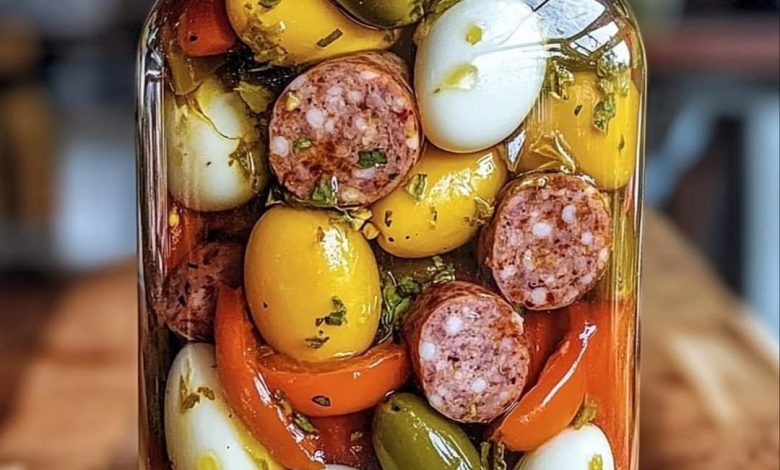
ADVERTISEMENT
The Art of Creating Homemade Pickled Antipasto
In the world of culinary delights, few things can elevate a meal like a well-crafted antipasto. A vibrant blend of flavors, textures, and colors, antipasto is a feast for both the eyes and the palate. Among the many variations, pickled antipasto stands out as a versatile and deeply flavorful option. With a combination of tangy pickles, savory cured meats, and rich cheeses, this jarred delight is a testament to the art of preservation and flavor harmony.
A Symphony of Ingredients
At the heart of any great antipasto is the quality of its ingredients. Pickled antipasto typically includes a variety of vegetables, meats, and cheeses, all preserved in a flavorful brine. The beauty of this dish lies in its flexibility—you can tailor the ingredients to suit your taste, making it as simple or as complex as you like.
Vegetables: The foundation of pickled antipasto often starts with a colorful array of vegetables. Classic choices include small, firm pickles like cornichons or gherkins, sweet cherry peppers, crunchy carrots, and vibrant olives. These vegetables are typically lightly pickled in a vinegar brine, giving them a tangy, crisp bite that contrasts beautifully with the richer components of the dish.
Meats: The next layer of flavor comes from cured meats. Slices of salami, pepperoni, or chorizo add a robust, savory note to the antipasto. These meats not only contribute their rich flavors but also bring a satisfying chewiness that complements the crunch of the vegetables.
Cheese: Small balls of fresh mozzarella, cubes of provolone, or even chunks of parmesan can be added to the mix. The cheese introduces a creamy, mellow element that balances the acidity of the pickles and the saltiness of the meats.
ADVERTISEMENT
Eggs: Quail eggs are a delightful addition to pickled antipasto. Their small size and rich, creamy yolk add an unexpected twist. When pickled, they absorb the flavors of the brine, making each bite a burst of tangy goodness.
Herbs and Spices: Fresh herbs like basil, parsley, and oregano can be added for a pop of green and an aromatic lift. Crushed garlic, peppercorns, and chili flakes contribute to the depth of flavor, making each mouthful complex and satisfying.
The Brining Process
The brine is the soul of pickled antipasto. It’s where all the ingredients come together, absorbing the flavors and developing their character over time. A basic brine is made from vinegar, water, salt, and sugar. The vinegar provides the tang, while the salt and sugar balance the flavors, preventing the brine from being too sharp.
For added depth, you can infuse the brine with additional flavors. Bay leaves, mustard seeds, dill, and coriander are popular choices that lend a distinctive taste. Heating the brine before pouring it over the ingredients helps to meld these flavors, ensuring that each component of the antipasto is perfectly seasoned.
Assembly and Preservation
Once the brine is prepared and slightly cooled, it’s time to assemble the antipasto. Start by layering the vegetables, meats, and cheeses in sterilized glass jars. The goal is to create a visually appealing mix, alternating colors and textures to ensure that every scoop of antipasto offers a little bit of everything.
ADVERTISEMENT
Pour the brine over the assembled ingredients, making sure they are fully submerged. Seal the jars with lids and allow them to cool to room temperature before refrigerating. While the antipasto can be enjoyed after just a few hours, letting it marinate for a few days will enhance the flavors, allowing them to meld and mature.
Serving Suggestions
Pickled antipasto is incredibly versatile. It can be served as a standalone appetizer, paired with crusty bread or crackers. It’s also a fantastic addition to a charcuterie board, adding a tangy contrast to creamy cheeses and rich pâtés. For a more substantial meal, toss the antipasto with pasta, or use it to top a salad.
The bright, acidic flavors of pickled antipasto make it an excellent companion to rich dishes, cutting through the heaviness and refreshing the palate. It’s equally at home alongside grilled meats or as a zesty side for sandwiches.
The Joy of Homemade Preservation
Making pickled antipasto at home is not just about creating a delicious dish—it’s also about embracing the art of preservation. There’s something deeply satisfying about transforming fresh ingredients into a long-lasting treat, one that can be enjoyed over weeks or even months.
The process of pickling and preserving is a time-honored tradition, one that connects us to our culinary heritage. It’s a way of capturing the flavors of the season, bottling them up for enjoyment long after the harvest has passed. Whether you’re an experienced home cook or a curious beginner, making pickled antipasto is a rewarding project, one that yields delicious results with minimal effort.
ADVERTISEMENT
Conclusion
Pickled antipasto is more than just a dish—it’s an exploration of flavors, a celebration of ingredients, and a testament to the joys of home preservation. With its vibrant mix of vegetables, meats, and cheeses, all bathed in a tangy, flavorful brine, it offers a little bit of everything in each bite. Whether served as an appetizer, a snack, or a main course, pickled antipasto is sure to impress and delight. So gather your ingredients, prepare your brine, and start pickling—because the best things in life are often made by hand, one jar at a time.




